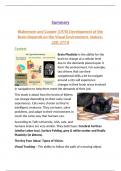Summary
Blakemore and Cooper (1970) Development of the
Brain Depends on the Visual Environment. Nature,
228: 277-8
Context
Brain Plasticity is the ability for the
brain to change at a cellular level
due to the demands placed upon it
form the environment. For example,
taxi drivers that use their
navigational skills a lot to navigate
around a city will experience
changes in their brain areas involved
in navigation to help them meet the demands of their job.
This study is about how the brains of kittens
can change depending on their early visual
experiences. Cats were chosen as they’re
intelligent creatures. They can learn, solve
problems, and adapt to their environment in
much the same way that humans can.
According to Tufts University, USA, cats, and
humans brains are very similar. They both have: Cerebral Cortices
(similar Lobes too), Surface Folding, grey & white matter and finally
Plasticity (in kittens).
The Key Four Ideas/ Types of Vision:
Visual Tracking – The ability to follow the path of a moving object.
, Depth Perception – The ability to judge the position of an object, to
establish how far away it is. Depth Perception is partly due to
Stereopsis; where the brain compares the view of the left and right
eye to give us the information that we need.
Monocular Vision – Vision from one eye.
Binocular Vision – Vision from to eyes.
Previous Research into Cat Vision and Plasticity:
Hubel & Weisel (1962) found that neurones in the visual cortex
(within a normal cat) responds to light and specific features of their
visual world. Therefore, the brain of the cat is able to make sense of
their surroundings from what they see, this allows them to see and
navigate their way around easily; like humans. However, they found
one type of neurone that is orientation specific. Meaning that certain
neurones respond specifically to lines and edges that are seen by
cats.
Each neurone responds to lines in a different direction, as though
there were different neurones to detect the minute hand of a clock.
These neurones can be stimulated by either eye, meaning that cat
vision is Binocular.
Hubel & Weisel (1970) found 8 years down the line that total visual
deprivation in kittens (reared in complete darkness) causes neurones
in the kittens’ brains that should be associated with the deprived
eyes decline in number. Meaning that as the eyes weren’t being
used, their brain changed by reducing the number of neurones
needed for their vision. This effect was greatest when the kittens
were between 4 and 8 weeks of age.
Hirsch and Spinelli (1970) found that early visual experience can
change neuronal organisation in kittens. Using special googles (made
one eye view vertical stripes only and the other view horizontal
stripes only), They found that neurones relating to each eye became




